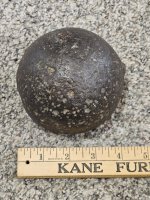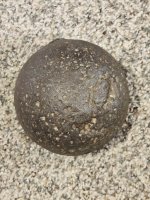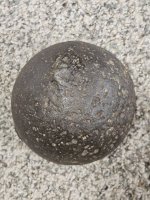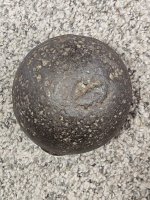Hello. I'm new to the forum. I found this at a garage sale and I'm not sure if it's a cannonball or not. It measures approximately 4 1/16" in diameter (It's hard to get an exact measurement do to the pits and bumps but it comes out pretty consistent) and weighs 9 pounds and 8 ounces. These measurements seem close to a Revolutionary War 9 pounder specs. It seems to be a sphere and not oval or egg shaped. I tried searching this site and other places but I'm still not clear on what it is. Thanks for your help!!
Navigation
Install the app
How to install the app on iOS
Follow along with the video below to see how to install our site as a web app on your home screen.
Note: This feature may not be available in some browsers.
More options
You are using an out of date browser. It may not display this or other websites correctly.
You should upgrade or use an alternative browser.
You should upgrade or use an alternative browser.
Is this a Cannonball?
- Thread starter russham
- Start date


Upvote
0
- Thread starter
- #4
Awesome That is EXCELLENT info. Thank you!!I noticed this was your very first post - so, Welcome Aboard russham!
Until a member pipes in - take a look at: CannonBallGuy .. Can you tell me anything about this? (Sep 30, 2012)
Upvote
1
TheCannonballGuy
Gold Member
- Feb 24, 2006
- 6,584
- 13,311
- Detector(s) used
- White's 6000, Nautilus DMC-1, Minelab
- Primary Interest:
- Relic Hunting
ARC is very probably right. Here's how we will know for certain:
The bore diameter of a 9-pounder smoothbore cannon is 4.20-inches. If the "bumps" on your iron ball cause its diameter to increase from 4.06" to more than 4.20", it would not fit into the muzzle of the 4.20"-bore cannon.
Also, according to the US Army's Ordnance Manual of 1861, a 9-Pounder caliber Solid-Shot cannonball was specified to weigh precisely 9.14 pounds (9 pounds 2 ounces). Unfortunately, your ball is fully 6 ounces too heavy to qualify as an actual 9-Pounder cannonball -- or any other version of cannonball.
You might want to try re-measuring your iron ball on a super-precise weighing scale, such as a Postal Shipping scale, to see if perhaps the scale you used is faulty, or if you made an error in your previous weighing.
If your measurements of this ball's weight and diameter are correct, then ARC is right... it is not a cannonball. At the moment, I agree with him, based on the ball's large bumps, and it getting disqualified for being "overweight."
The bore diameter of a 9-pounder smoothbore cannon is 4.20-inches. If the "bumps" on your iron ball cause its diameter to increase from 4.06" to more than 4.20", it would not fit into the muzzle of the 4.20"-bore cannon.
Also, according to the US Army's Ordnance Manual of 1861, a 9-Pounder caliber Solid-Shot cannonball was specified to weigh precisely 9.14 pounds (9 pounds 2 ounces). Unfortunately, your ball is fully 6 ounces too heavy to qualify as an actual 9-Pounder cannonball -- or any other version of cannonball.
You might want to try re-measuring your iron ball on a super-precise weighing scale, such as a Postal Shipping scale, to see if perhaps the scale you used is faulty, or if you made an error in your previous weighing.
If your measurements of this ball's weight and diameter are correct, then ARC is right... it is not a cannonball. At the moment, I agree with him, based on the ball's large bumps, and it getting disqualified for being "overweight."
Upvote
3
ARC
Gold Member
- Aug 19, 2014
- 37,963
- 136,676
- Detector(s) used
- JW 8X-ML X2-VP 585
- Primary Interest:
- All Treasure Hunting
Yeah,,, its the bumps and lumps that throw it off.ARC is very probably right. Here's how we will know for certain:
The bore diameter of a 9-pounder smoothbore cannon is 4.20-inches. If the "bumps" on your iron ball cause its diameter to increase from 4.06" to more than 4.20", it would not fit into the muzzle of the 4.20"-bore cannon.
Also, according to the US Army's Ordnance Manual of 1861, a 9-Pounder caliber Solid-Shot cannonball was specified to weigh precisely 9.14 pounds (9 pounds 2 ounces). Unfortunately, your ball is fully 6 ounces too heavy to qualify as an actual 9-Pounder cannonball -- or any other version of cannonball.
You might want to try re-measuring your iron ball on a super-precise weighing scale, such as a Postal Shipping scale, to see if perhaps the scale you used is faulty, or if you made an error in your previous weighing.
If your measurements of this ball's weight and diameter are correct, then ARC is right... it is not a cannonball. At the moment, I agree with him, based on the ball's large bumps, and it getting disqualified for being "overweight."
CBG... perhaps corrosion lumps ?
Add weight ?
Upvote
0
TheCannonballGuy
Gold Member
- Feb 24, 2006
- 6,584
- 13,311
- Detector(s) used
- White's 6000, Nautilus DMC-1, Minelab
- Primary Interest:
- Relic Hunting
ARC asked:
> CBG... perhaps corrosion lumps ? Add weight ?
No. Corrosion subtracts weight. Concretion adds weight.
The single distinct bump looks like a casting-mold sprue. The irregular lumps look like the mold's sandcore broke during the ironcasting process. But the lumps don't look big enough to add 6 ounces to the ball's weight. Something is "off" somewhere. Maybe re-weighing the ball will help. Also, maybe re-measuring the ball ACROSS THE TOPS of the lumps and bumps will tell us something important. Important note: To do that ("across the tops"), a caliper must be used... a tape-measure won't work in this case. Set one point of the caliper on the highest bump.
If the reported weight (9 pounds 8 ounces) is correct... I just don't see an Artillery Ordnance Inspector accepting the overweight ball. Why? Because a cannonball's weight is very important in AIMING it accurately. The propellant powder charge issued with the cannonball is based on the ball weighing exactly what it is specified to be. If the ball is overweight, it will fall short of what it is aimed at. I'm too ill to go into further details about that. I hope this explanation is sufficient.
Regards,
TheCannonballGuy
> CBG... perhaps corrosion lumps ? Add weight ?
No. Corrosion subtracts weight. Concretion adds weight.
The single distinct bump looks like a casting-mold sprue. The irregular lumps look like the mold's sandcore broke during the ironcasting process. But the lumps don't look big enough to add 6 ounces to the ball's weight. Something is "off" somewhere. Maybe re-weighing the ball will help. Also, maybe re-measuring the ball ACROSS THE TOPS of the lumps and bumps will tell us something important. Important note: To do that ("across the tops"), a caliper must be used... a tape-measure won't work in this case. Set one point of the caliper on the highest bump.
If the reported weight (9 pounds 8 ounces) is correct... I just don't see an Artillery Ordnance Inspector accepting the overweight ball. Why? Because a cannonball's weight is very important in AIMING it accurately. The propellant powder charge issued with the cannonball is based on the ball weighing exactly what it is specified to be. If the ball is overweight, it will fall short of what it is aimed at. I'm too ill to go into further details about that. I hope this explanation is sufficient.
Regards,
TheCannonballGuy
Upvote
4
- Thread starter
- #9
Thank you for that!! Since you seem to be the guy, I'll go with that. I'll take the calipers out and see what come out. I'll wiegh it on my other postal scale to see if that shows different. Thanks again!! I'll report back.ARC is very probably right. Here's how we will know for certain:
The bore diameter of a 9-pounder smoothbore cannon is 4.20-inches. If the "bumps" on your iron ball cause its diameter to increase from 4.06" to more than 4.20", it would not fit into the muzzle of the 4.20"-bore cannon.
Also, according to the US Army's Ordnance Manual of 1861, a 9-Pounder caliber Solid-Shot cannonball was specified to weigh precisely 9.14 pounds (9 pounds 2 ounces). Unfortunately, your ball is fully 6 ounces too heavy to qualify as an actual 9-Pounder cannonball -- or any other version of cannonball.
You might want to try re-measuring your iron ball on a super-precise weighing scale, such as a Postal Shipping scale, to see if perhaps the scale you used is faulty, or if you made an error in your previous weighing.
If your measurements of this ball's weight and diameter are correct, then ARC is right... it is not a cannonball. At the moment, I agree with him, based on the ball's large bumps, and it getting disqualified for being "overweight."
Upvote
1
- Thread starter
- #11
Okay. I measured across to the biggest bump and it comes out close to 4.25". Note that that bump is probably about 1/8" from the rest of the surface. The weight on my other scale puts it at 9 lbs. 7.5 oz. I shall assume from the info given that it is definitely not a cannonball. What else could it be? One of those ball mill balls? Thanks everyone for the help!!ARC asked:
> CBG... perhaps corrosion lumps ? Add weight ?
No. Corrosion subtracts weight. Concretion adds weight.
The single distinct bump looks like a casting-mold sprue. The irregular lumps look like the mold's sandcore broke during the ironcasting process. But the lumps don't look big enough to add 6 ounces to the ball's weight. Something is "off" somewhere. Maybe re-weighing the ball will help. Also, maybe re-measuring the ball ACROSS THE TOPS of the lumps and bumps will tell us something important. Important note: To do that ("across the tops"), a caliper must be used... a tape-measure won't work in this case. Set one point of the caliper on the highest bump.
If the reported weight (9 pounds 8 ounces) is correct... I just don't see an Artillery Ordnance Inspector accepting the overweight ball. Why? Because a cannonball's weight is very important in AIMING it accurately. The propellant powder charge issued with the cannonball is based on the ball weighing exactly what it is specified to be. If the ball is overweight, it will fall short of what it is aimed at. I'm too ill to go into further details about that. I hope this explanation is sufficient.
Regards,
TheCannonballGuy
Upvote
2
TheCannonballGuy
Gold Member
- Feb 24, 2006
- 6,584
- 13,311
- Detector(s) used
- White's 6000, Nautilus DMC-1, Minelab
- Primary Interest:
- Relic Hunting
Russham said:
> The weight on my other scale puts it at 9 lbs. 7.5 oz.
> I shall assume from the info given that it is definitely not a cannonball.
Yes, definitely not. As I previously indicated, a 4.25"-diameter ball will not fit into the muzzle of a 4.20"-bore cannon. The ball being significantly heavier than the nearest-size actual historical cannonball is a second "final nail in the coffin." ;-)
> What else could it be? One of those ball mill balls?
There are several other possibilities, but a Mill Ball is statistically the most likely ID... because literally millions of Mill-Balls have been manufactured.
> Thanks everyone for the help!!
You're welcome.
You did the smart thing, coming here and asking for identification assistance. Never trust what somebody says on Ebay.
By the way... your public expression of gratitude helps keep this forum's all-unpaid volunteer Identification-Helpers motivated to continue. Too many ID-requesters never bother to say thank you.
> The weight on my other scale puts it at 9 lbs. 7.5 oz.
> I shall assume from the info given that it is definitely not a cannonball.
Yes, definitely not. As I previously indicated, a 4.25"-diameter ball will not fit into the muzzle of a 4.20"-bore cannon. The ball being significantly heavier than the nearest-size actual historical cannonball is a second "final nail in the coffin." ;-)
> What else could it be? One of those ball mill balls?
There are several other possibilities, but a Mill Ball is statistically the most likely ID... because literally millions of Mill-Balls have been manufactured.
> Thanks everyone for the help!!
You're welcome.
You did the smart thing, coming here and asking for identification assistance. Never trust what somebody says on Ebay.
By the way... your public expression of gratitude helps keep this forum's all-unpaid volunteer Identification-Helpers motivated to continue. Too many ID-requesters never bother to say thank you.
Upvote
3
- Thread starter
- #13
Well thank you again sir! Saying thank you is the least I can do. It takes a couple of seconds of typing. I just don't understand some people these days. I appreciate EVERYONE'S help here! This is a great forum and have a nice metal detector now and plan to see if I can find any gold or meteorite fragments here in southwest AZ. Maybe you guys will see me around. Hopefully you will. That means I found something. Cheers!!Russham said:
> The weight on my other scale puts it at 9 lbs. 7.5 oz.
> I shall assume from the info given that it is definitely not a cannonball.
Yes, definitely not. As I previously indicated, a 4.25"-diameter ball will not fit into the muzzle of a 4.20"-bore cannon. The ball being significantly heavier than the nearest-size actual historical cannonball is a second "final nail in the coffin." ;-)
> What else could it be? One of those ball mill balls?
There are several other possibilities, but a Mill Ball is statistically the most likely ID... because literally millions of Mill-Balls have been manufactured.
> Thanks everyone for the help!!
You're welcome.
You did the smart thing, coming here and asking for identification assistance. Never trust what somebody says on Ebay.
By the way... your public expression of gratitude helps keep this forum's all-unpaid volunteer Identification-Helpers motivated to continue. Too many ID-requesters never bother to say thank you.
Upvote
2
Top Member Reactions
-
 3472
3472 -
 1993
1993 -
 1723
1723 -
 1444
1444 -
 1197
1197 -
 1178
1178 -
 916
916 -
 886
886 -
 822
822 -
 821
821 -
 650
650 -
 613
613 -
 475
475 -
 474
474 -
E
459
-
 449
449 -
 408
408 -
 389
389 -
 358
358 -
 334
334
Users who are viewing this thread
Total: 2 (members: 0, guests: 2)
Latest Discussions
-
-
-
-
-
Russkamrad Carbon Fiber Telescopic Rod for Excalibur II
- Latest: Detectorinator
-








